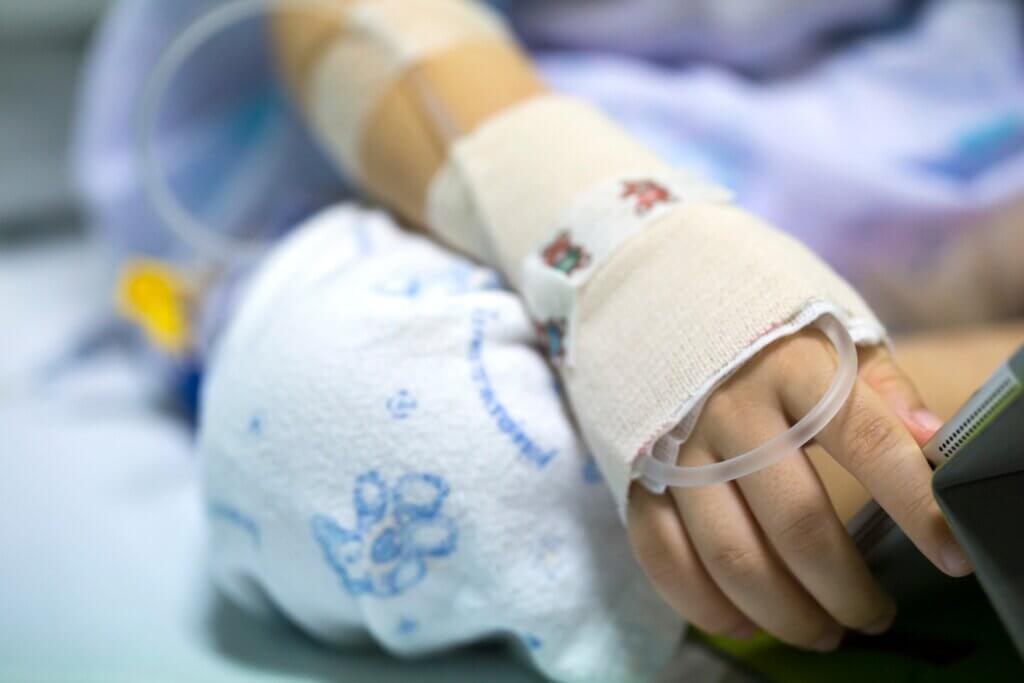Diphtheria: Symptoms, Causes and Treatment

Diphtheria is a now rare upper respiratory tract infection that can be life-threatening in the absence of vaccinations. Experts remind us that, before the introduction of the vaccine in industrialized countries in the 1940s and 1950s, it was one of the leading causes of infant mortality. Since then, cases have dropped to an average of 5,000 a year worldwide.
The infection is currently concentrated in countries with no vaccination programs and poor medical care due to social unrest, armed conflicts, famines, natural disasters, economic crises, and so on. Diphtheria is no longer considered a major public health threat, but neglect of it has led to major outbreaks in recent years.
Symptoms of diphtheria
The term diphtheria is derived from the Greek word diphthéra which translates as ‘skin’ or ‘membrane’. This is an allusion to the characteristics of the pseudomembrane that is produced during the course of the infection.
It occurs mainly in the respiratory system and in the integumentary system (skin, hair, and nails). Therefore, its symptoms vary according to the part of the body affected.
When the infection is concentrated in the respiratory system, it’s usually called respiratory diphtheria. For its part, when it’s concentrated in the integumentary system, it’s usually called diphtheria skin infection. Let’s take a look at the most important medical signs:
- Sore throat
- Difficulty swallowing
- Swollen glands in the neck
- Difficulty breathing
- Hoarseness
- Weakness
- Loss of appetite
The bacterium causing the infection produces a toxin that kills healthy tissue in the areas it infects. In this case, it kills the tissues of the upper respiratory system.
After a couple of days, the dead tissue produces a gray coating that doctors call a pseudomembrane. This can appear in the nose, tonsils, larynx, and throat. Let us now mention the symptoms of diphtheria skin infection:
- Vesicles or pustules on the surface of the skin
- Superficial ulcers with protruding edges
- Development of a greyish-brown adherent membrane at the base
- Skin with a “rolled” appearance
Most episodes focus on the hands, feet, and legs. Infections of this type are much milder than those of the respiratory system, although it may take several months for the skin symptoms to disappear completely.
If the toxins enter the bloodstream or internal tissues, complications such as myocarditis, neuritis, renal failure, polyneuritis, osteomyelitis, and others may manifest.
Causes of diphtheria

As specialists well point out, diphtheria is an infection caused by species of Corynebacterium bacteria, mainly Corynebacterium diphtheria. Corynebacterium ulcerans tends to concentrate most of the cases on the surface of the skin.
These microorganisms naturally inhabit soil, plants, animals, and even humans.
The bacteria produce an exotoxin that causes a localized inflammatory reaction followed by necrosis and tissue destruction. This is what essentially produces the complications associated with infections. Transmission is through respiratory droplets from infected persons or by contact with an infected host or carrier.
Although less common, infection can occur from direct contact with objects or secretions on the surfaces that have been in contact with the infected person. Most of the time the bacterium colonizes the upper respiratory tract, rarely disseminating systemically. The average incubation period ranges from 2 to 5 days.
Most outbreaks are currently concentrated in countries with poor medical care, lack of vaccination programs, and in conflict situations. Bangladesh, Indonesia, Venezuela, Yemen, and Haiti have all had major outbreaks in recent years. A trip to an endemic region without vaccination records is considered a risk for infection.
Diagnosis of diphtheria
The diagnosis is usually made on the basis of a clinical evaluation. In addition to the symptoms described, the presence of a greyish/whitish/blackish pseudomembrane in the wall of the tonsils or pharynx is what alerts the specialist to a possible case of diphtheria. To confirm this finding, the following are carried out:
- Toxin and bacteriological tests
- A complete blood count
- Imaging studies (to assess inflammation of the tissues of the upper respiratory system)
Children, the elderly, pregnant women, people with compromised immune systems, and those who have traveled to an endemic or recent outbreak country without the vaccination schedule are considered at risk. In some cases, the infection can be fatal, so an early diagnosis improves the prognosis and outcome.
Treatment options

Because of the complications associated with the infection, treatment for diphtheria is carried out immediately after diagnosis. Standard therapy consists of two aspects: administering antibiotics and diphtheria antitoxin.
The most commonly used antibiotics in this case are erythromycin and penicillin G. Cases showing resistance can be addressed with linezolid or vancomycin.
Diphtheria antitoxin is an antiserum derived from horses whose function is to neutralize the toxin that causes the symptoms. It can be administered intramuscularly or intravenously, and the patient is always subjected to a hypersensitivity test to avoid complications. Even after overcoming it, anti-anaphylaxis medications should be kept close to the patient.
Antibiotic-based treatment lasts for weeks. If the cultures should show the presence of the bacteria, doctors will consider extending the treatment for an additional 10 days.
There have been concerns about cases of antibiotic resistance in these bacteria, so a culture should always be carried out after completing the indicated treatment.
Diphtheria is a now rare upper respiratory tract infection that can be life-threatening in the absence of vaccinations. Experts remind us that, before the introduction of the vaccine in industrialized countries in the 1940s and 1950s, it was one of the leading causes of infant mortality. Since then, cases have dropped to an average of 5,000 a year worldwide.
The infection is currently concentrated in countries with no vaccination programs and poor medical care due to social unrest, armed conflicts, famines, natural disasters, economic crises, and so on. Diphtheria is no longer considered a major public health threat, but neglect of it has led to major outbreaks in recent years.
Symptoms of diphtheria
The term diphtheria is derived from the Greek word diphthéra which translates as ‘skin’ or ‘membrane’. This is an allusion to the characteristics of the pseudomembrane that is produced during the course of the infection.
It occurs mainly in the respiratory system and in the integumentary system (skin, hair, and nails). Therefore, its symptoms vary according to the part of the body affected.
When the infection is concentrated in the respiratory system, it’s usually called respiratory diphtheria. For its part, when it’s concentrated in the integumentary system, it’s usually called diphtheria skin infection. Let’s take a look at the most important medical signs:
- Sore throat
- Difficulty swallowing
- Swollen glands in the neck
- Difficulty breathing
- Hoarseness
- Weakness
- Loss of appetite
The bacterium causing the infection produces a toxin that kills healthy tissue in the areas it infects. In this case, it kills the tissues of the upper respiratory system.
After a couple of days, the dead tissue produces a gray coating that doctors call a pseudomembrane. This can appear in the nose, tonsils, larynx, and throat. Let us now mention the symptoms of diphtheria skin infection:
- Vesicles or pustules on the surface of the skin
- Superficial ulcers with protruding edges
- Development of a greyish-brown adherent membrane at the base
- Skin with a “rolled” appearance
Most episodes focus on the hands, feet, and legs. Infections of this type are much milder than those of the respiratory system, although it may take several months for the skin symptoms to disappear completely.
If the toxins enter the bloodstream or internal tissues, complications such as myocarditis, neuritis, renal failure, polyneuritis, osteomyelitis, and others may manifest.
Causes of diphtheria

As specialists well point out, diphtheria is an infection caused by species of Corynebacterium bacteria, mainly Corynebacterium diphtheria. Corynebacterium ulcerans tends to concentrate most of the cases on the surface of the skin.
These microorganisms naturally inhabit soil, plants, animals, and even humans.
The bacteria produce an exotoxin that causes a localized inflammatory reaction followed by necrosis and tissue destruction. This is what essentially produces the complications associated with infections. Transmission is through respiratory droplets from infected persons or by contact with an infected host or carrier.
Although less common, infection can occur from direct contact with objects or secretions on the surfaces that have been in contact with the infected person. Most of the time the bacterium colonizes the upper respiratory tract, rarely disseminating systemically. The average incubation period ranges from 2 to 5 days.
Most outbreaks are currently concentrated in countries with poor medical care, lack of vaccination programs, and in conflict situations. Bangladesh, Indonesia, Venezuela, Yemen, and Haiti have all had major outbreaks in recent years. A trip to an endemic region without vaccination records is considered a risk for infection.
Diagnosis of diphtheria
The diagnosis is usually made on the basis of a clinical evaluation. In addition to the symptoms described, the presence of a greyish/whitish/blackish pseudomembrane in the wall of the tonsils or pharynx is what alerts the specialist to a possible case of diphtheria. To confirm this finding, the following are carried out:
- Toxin and bacteriological tests
- A complete blood count
- Imaging studies (to assess inflammation of the tissues of the upper respiratory system)
Children, the elderly, pregnant women, people with compromised immune systems, and those who have traveled to an endemic or recent outbreak country without the vaccination schedule are considered at risk. In some cases, the infection can be fatal, so an early diagnosis improves the prognosis and outcome.
Treatment options

Because of the complications associated with the infection, treatment for diphtheria is carried out immediately after diagnosis. Standard therapy consists of two aspects: administering antibiotics and diphtheria antitoxin.
The most commonly used antibiotics in this case are erythromycin and penicillin G. Cases showing resistance can be addressed with linezolid or vancomycin.
Diphtheria antitoxin is an antiserum derived from horses whose function is to neutralize the toxin that causes the symptoms. It can be administered intramuscularly or intravenously, and the patient is always subjected to a hypersensitivity test to avoid complications. Even after overcoming it, anti-anaphylaxis medications should be kept close to the patient.
Antibiotic-based treatment lasts for weeks. If the cultures should show the presence of the bacteria, doctors will consider extending the treatment for an additional 10 days.
There have been concerns about cases of antibiotic resistance in these bacteria, so a culture should always be carried out after completing the indicated treatment.
- Chaudhary, A., & Pandey, S. Corynebacterium Diphtheriae. StatPearls Publishing. 2021.
- Hoskisson PA. Microbe Profile: Corynebacterium diphtheriae – an old foe always ready to seize opportunity. Microbiology (Reading). 2018 Jun;164(6):865-867.
- Truelove SA, Keegan LT, Moss WJ, Chaisson LH, Macher E, Azman AS, Lessler J. Clinical and Epidemiological Aspects of Diphtheria: A Systematic Review and Pooled Analysis. Clin Infect Dis. 2020 Jun 24;71(1):89-97.
Este texto se ofrece únicamente con propósitos informativos y no reemplaza la consulta con un profesional. Ante dudas, consulta a tu especialista.







